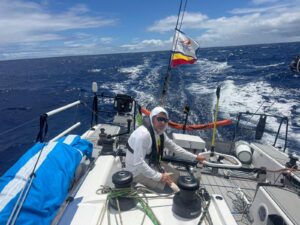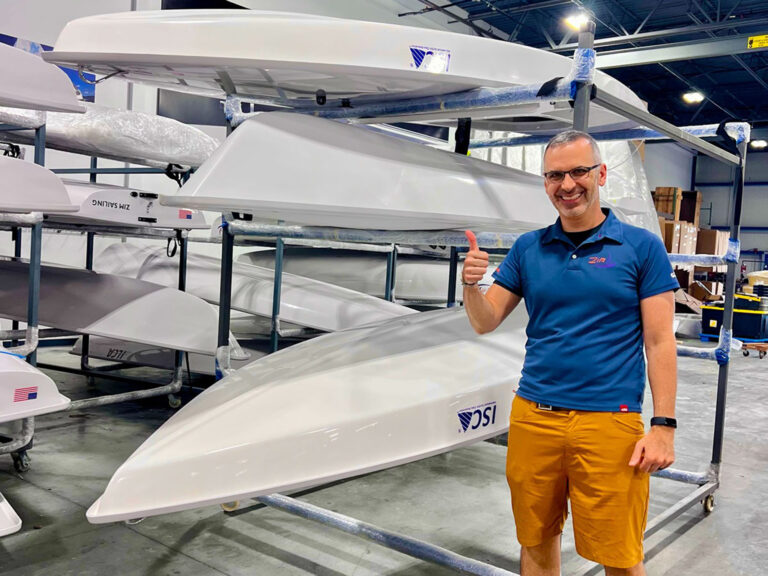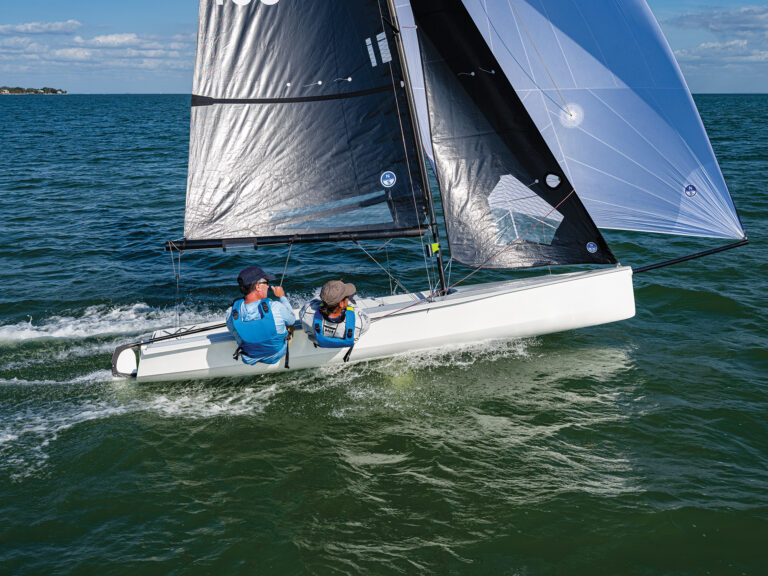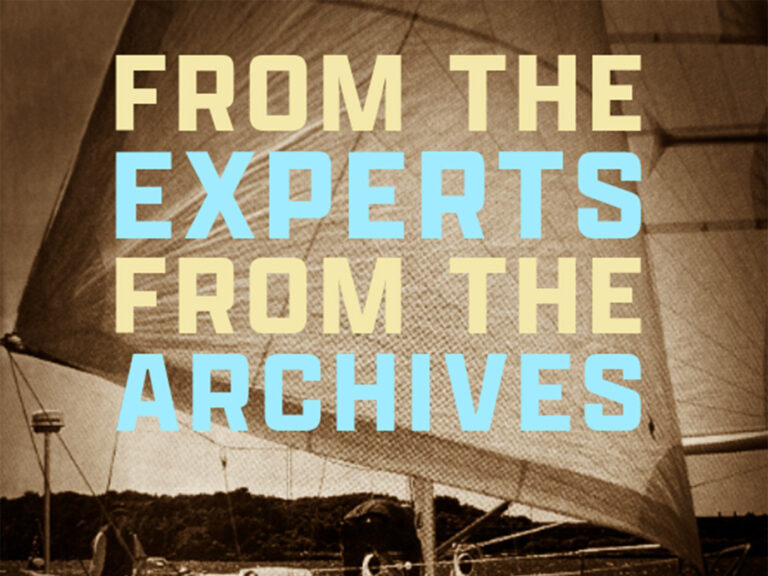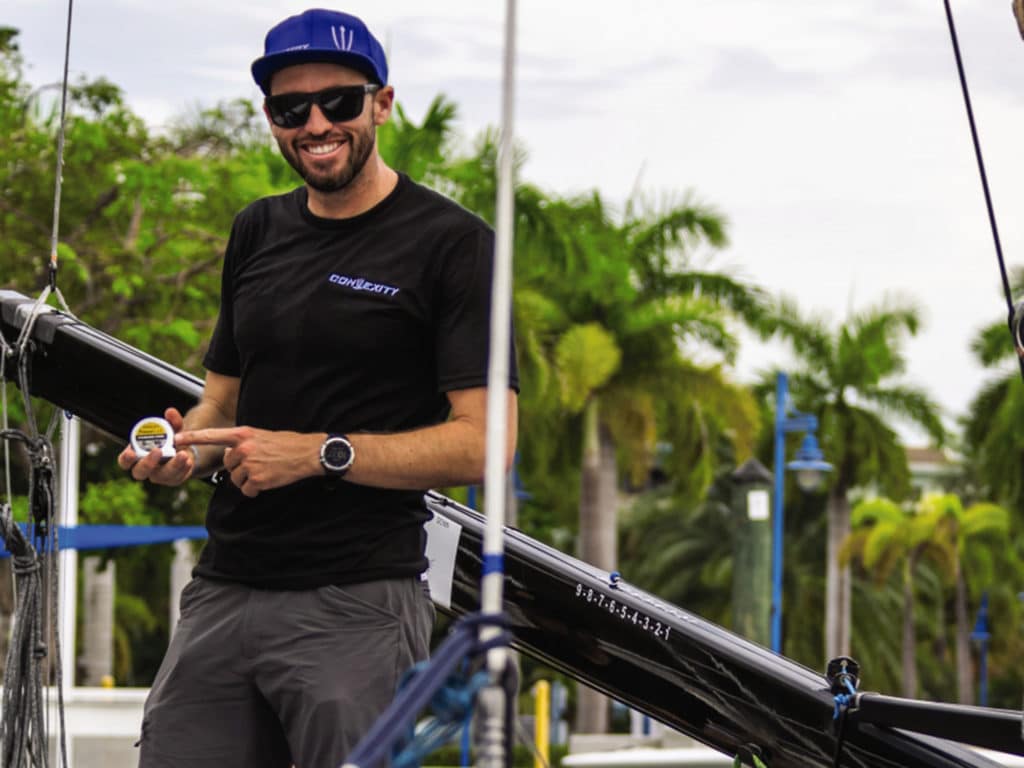
On a Friday afternoon in late January, Taylor Canfield is fried after another day on Biscayne Bay. The year is still new, and he’s already put in a couple of weeks in Key West. He’ll be hitting the racecourse hard, as he always does. There’s the M32 catamaran winter series on tap and a bunch more ahead with Laura Grondin’s two-boat Dark Energy program, which he manages. Before he knows it, he’ll be planning past his previous year’s tally of sailing days, which he guesstimates to be north of 200, maybe 250. It’s a good living as one of American sailing’s best young pros—he is the reigning five-time Congressional Cup winner, the M32 world champion tactician, and a top-tier talent in the one-design classes where he plies his trade. His win list is certainly worthy of his spot on the Rolex Yachtsman of the Year shortlist, but today he’s not looking back or worrying about any list.
He’s got bigger and better plans: a couple of world championships, and there’s that America’s Cup thing, especially. He and Stars+Stripes co-founder Mike Buckley are hustling to build a war chest. The urgency, however, is weighing on his mind, just like the day of Melges 24 racing he’s endured when we connect by phone on his walk home from the boat in Miami.
How’s it going down there?
Ha. You caught me on my worst day of sailing in a while.
Really? You’re racing in Miami in January; how bad could that be?
It was a normal day. I got up, got on the bike and got my legs moving, which energizes me. Then [I checked] in with Buckley, who’s always got things to talk about in the morning. Got to the boat—I don’t have to worry because it’s always perfect and ready to go sailing. We did our pre-race and felt we were going well, as we have been for the past couple [of] months. All three starts were good, we had boatspeed, got on the lifted tack as fast as we could and then—I don’t know. It was tricky. In the first race, I got in the middle and was bouncing between two breezes. Next race, we were doing fine, and then just got unlucky with a gigantic shift that we were on the wrong side of.
When you say the boat was going well, what does that mean?
For me, it’s a feel thing. Laura is an incredible driver. She’s super- focused and always keeping the boat fast and the heel angle locked. That’s the most important thing in keelboats or dinghies like these—it’s all heel angle. One thing we’ve changed in this [Melges 24] class as a team is that I am more proactive with trimming the main, so I sit more legs in more than most other teams. This lets Laura really focus more on the driving. When I’m legs in, I can adjust everything more; there are so many controls on this boat. To transition quickly is how we can make the most gains.
Or are you just trying to get out of hiking?
There are times where I’m sure my teammates are wishing I was hiking more, but we’re working on the balance of when I should be hiking and when I should be trimming.
What’s it like to sail with you?
I’m a complete pain in the ass. I’m the most meticulous, demanding and hyper-focused person you could sail with. I don’t know if it’s a good thing or my downfall, but I try to let nothing go by. I can be hard on the team, but it helps us grow and get better. They know everything I’m saying—good or bad—is in the interest of the team.
What sets you off?
Ill preparation—the little things, like getting off the dock late, water bottles not filled, someone cutting their gloves as we’re trying to dock off. I believe in having a plan, sticking to it and being ready to go. If that happens, I’m usually pretty happy for the rest of the day.
Is that your personality or something you’ve picked up as a pro?
I definitely picked it up from other programs, but for me, if I can eliminate those things that will bother someone, it will make the day that much better. As a kid, I had some OCD tendencies. Growing up, our boats were always stored on the beach, and there was never a speck of sand in my boat.
As a tactician, what are your bad habits? Kind of like sending yourself back to the middle too many times today?
(Laughs) I was apologizing to the team all day. The best way to lead is by example, and if I put my hand up first, then the rest of the team will as well. I am hard on myself, and I get upset when I don’t sail as well as I know I can. I don’t let it drag me down, though. A bad shift is a bad shift, so keeping positive, driving the boat well is key. I’ll vent a bit, get it out of my system, and then I’m pretty much refocused. Or at least I try to be. It’s just my competitive nature that I’m always pushing to gain any boats we can.
What’s your pre-race routine?
Making sure the boat is ready to go, especially the rig. One of my biggest pet peeves is someone turning the shrouds the wrong way—there’s no excuse for that. We go out early, figure out what’s happening with the conditions. I’ll do 10 or more wind shots in the last 20 minutes before the race, check line bias, and make sure our pings are spot on. I also drive the boat around in the prestart just to feel the pressure and what the boat feels like. We do our upwind work for compass headings on both tacks and figure out our moding downwind.
Given what you’ve accomplished so far in so many classes, what’s preventing you from getting recruited by the big-boat programs?
I don’t know, to be honest. A lot of the big teams have been together for years. It’s just the same group of guys chipping away and doing the same jobs. They started doing it when they were 30 years old, and they’re still doing it at 60. I don’t know if it’s just the generation I’ve grown up in that is part of the issue, but it’s been unfortunate. It does feel like I deserve an opportunity to go sail on a TP52 or something of that nature. It sometimes feels that being an American holds me back a bit, which I hate to say, and that’s what Mike and I are working to change. It’s a priority that the sport grows in this country so the next generation has a better opportunity to get to the top of the sport.
A lot of the big teams have been together for years. It’s just the same group of guys chipping away and doing the same jobs.
The little things we’ve done, like having the Stars+Stripes Development Team, getting some young match racers out to train with us for the Congressional Cup—that’s why we started Stars+Stripes. It will be an American team, 100 percent. It’s frustrating because we are in this lost generation where the previous generations have not passed down the torch. We need to do a better job of that in the future.
I’ve done some Farr40 stuff and have had some other opportunities that, for the most part, went pretty well, but that’s one tier below the next step. I don’t think you get noticed for that. You have to go and win a J/70 or Melges 24 world championship to get noticed. Maybe it’s on me to reach out to more teams and say I’m available.
What’s the key skillset or experience you think you’re lacking and want to have?
Running a big team. I’ve worked with a lot of small teams, but going in and being the tactician and manager would be a cool opportunity. To make the calls, run the meetings and be the guy that’s coming up with the plan for the day, making the schedule for the year and putting all the pieces together. I’m at a good point in my career where I want to focus on sailing, but I’m looking for an opportunity to be part of a bigger program. Mike and I are doing it with Stars+Stripes: the fundraising, building a business plan.
Speaking of the America’s Cup, how do you get there?
We’re in a decent place, but it’s a constant battle. We have a good group of private and corporate partners coming together with a huge focus on technology. We’ve started what we’re calling “The Founding Foilers” to give passionate individuals an opportunity to get involved in our team at a very basic grassroots level that will help provide the resources needed to keep moving toward the finish line.
So, you’ve got a Cup team to build and fund, and two demanding world championships to work for; what else do you have time for?
In the winter, I try to hang in Newport [Rhode Island] and get up to the mountains and snowboard. That wasn’t part of my life growing up in the islands, so I’m trying to take that on. I love cycling, and I have a road bike that I want to get on more days this year. I didn’t get many last year with all the sailing. I also love playing squash.
Are you into the whole psychology part of the game? Like, have you studied it?
Absolutely not. I just love how the hard work pays off—when the heart rate is up and just not giving up. If you give it that little extra to get to that one ball—it’s super-rewarding to make that nice shot after working your ass off. And it’s a good sweat. I fight to the death—every point.

